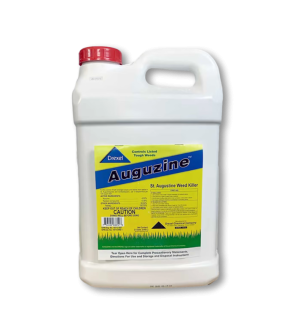Gain access to personalized product screening, the best pricing, rewards, and more!
Most Effective Products
Atrazine
While Glyphosate may be the most commonly used herbicide to treat invasive weeds in the United States, another herbicide known as Atrazine is close behind; because glyphosate has been so widely used, crops and plants have adapted over time to become more resistant to it, and as a result, Atrazine was formed to battle against those resistant plants. Many agricultural experts recommend mixing Atrazine with glyphosate to combat Glyphosate-resistant plants.
On this page, you can learn some interesting facts about this herbicide and how it works, as well as shop our recommended Atrazine-based herbicides.
What is Atrazine?
Atrazine is a triazine herbicide and the second most widely used herbicide in the US, with nearly 80 million pounds used yearly. It plays an important part in the agricultural industry and provides successful results as a pre- and post-emergent. It is primarily used to control broadleaf and grassy weeds that invade crops such as sorghum, corn, sugarcane, and pine, among other important plants.
How Does Atrazine Work?
Mode of Action
Atrazine selectively kills target weeds, interfering with the plant's growth and causing it to die. It works by interfering with photosynthesis, which is unique to green, living plants. Photosynthesis happens when light energy is converted to chemical energy needed for food production. Put another way, when food production stops, plants eventually starve to death.
Benefits of Atrazine
Atrazine works as both a pre-emergent when applied to the soil and a post-emergent on the grown plants themselves, making it quite a versatile herbicide. It also eliminates weed competition, making all the soil nutrients and moisture go to the crop rather than the weed.
Atrazine is a selective herbicide, meaning it can kill weeds without injuring the crop, making it exceptionally popular in the agricultural industry. Aside from the benefits it brings to agricultural farmers, Atrazine can also be used for residential weed control to improve the aesthetics of lawns. Atrazine is a popular weed control tool because it is economical, extremely effective against a spectrum of weeds, and very safe for the crop. Research has documented the benefits of atrazine to the bottom line for growers.
Use Atrazine on your landscape to target stubborn or persistent weeds that have become Glyphosate-resistant.
Drawbacks of Atrazine
Much like Glyphosate, Atrazine can also become ineffective when overuse leads to resistance from target weeds. In addition, while it is a selective active ingredient, there are some grass types that you should not use Atrazine on. Atrazine is a slow-acting weed, so you will have to be patient and persistent to see satisfying results. Atrazine is also a restricted-use active ingredient and cannot be purchased without an applicator's license.
Do not use Atrazine if you have a lawn that is not St. Augustine or Centipedegrass. (For example, if you have a Bermudagrass lawn, you should not use Atrazine for weed control. Check the label for specifics). Also, do not use Atrazine if rainfall is on the forecast, as it may decrease the product's effectiveness.
Is Atrazine Safe?
Atrazine is safe to use when applied according to the label directions. Keep pets and children off the treated area until the ground has had time to dry completely. Also, please make sure to wear the proper Personal Protective Equipment (safety gloves, goggles, long-sleeve clothes, and possibly a respiratory safety mask) when handling this product.
What To Expect

How long it takes to see results from an application of Atrazine can vary somewhat, depending on the type of weeds you target. Typically, Atrazine is a very slow-acting herbicide, and it can take up to 4 to 6 weeks after application to see the desired results and death of the target weed.
Featured Products
Atrazine 4L Herbicide—A restricted-use herbicide, Atrazine 4L herbicide is used for season-long weed control in turf grasses. It will also control most annual broadleaf and grass weeds in corn, sorghum, sugarcane, and certain other crops as specified on the label.







